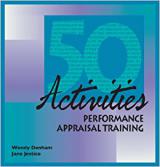
How to Conduct Painless Performance Appraisals: A Comprehensive Guide
By Business Training Media
Performance appraisals play a crucial role in evaluating an employee's achievements, identifying areas of improvement, and fostering professional growth. However, the process can often be stressful and uncomfortable for both managers and employees. In this article, we will discuss effective strategies and best practices to conduct painless performance appraisals, ensuring a positive and productive experience for all parties involved.
-
Establish Clear Objectives: Before conducting performance appraisals, it is essential to establish clear objectives and expectations. Communicate these goals to employees well in advance, allowing them to understand the evaluation criteria and prepare accordingly. Transparent expectations not only alleviate anxiety but also provide a fair basis for assessment.
-
Maintain Regular Feedback Channels: Performance appraisals should not be the sole instance of feedback throughout the year. Encourage regular communication and feedback sessions, providing employees with ongoing guidance and support. This approach reduces surprises during the formal appraisal and allows for more constructive discussions.
-
Create a Supportive Environment: A positive and supportive environment is crucial during performance appraisals. Ensure that the atmosphere is conducive to open and honest dialogue. Managers should adopt an empathetic and non-confrontational approach, fostering a safe space for employees to express their thoughts, concerns, and aspirations.
-
Focus on Both Strengths and Areas of Improvement: Performance appraisals should not solely emphasize weaknesses or areas requiring improvement. Acknowledge and appreciate an employee's strengths and achievements, as it boosts morale and motivation. Equally, identify areas that require development and offer guidance on how to enhance performance effectively.
-
Use a Two-Way Communication Approach: Conduct performance appraisals as a two-way conversation rather than a one-sided evaluation. Encourage employees to share their own perceptions of their performance, challenges faced, and ideas for growth. This approach promotes engagement, ownership, and a sense of partnership between the employee and manager.
-
Provide Constructive Feedback: While discussing areas of improvement, ensure feedback is constructive and specific. Focus on the behavior or outcome that requires attention, provide examples, and suggest practical solutions. Constructive feedback should inspire growth and development, fostering a sense of empowerment and commitment to improvement.
-
Set Attainable Goals: Goal-setting is an integral part of performance appraisals. Collaborate with employees to set realistic and attainable goals that align with the organization's objectives. Ensure goals are specific, measurable, achievable, relevant, and time-bound (SMART). When employees are involved in the goal-setting process, they are more likely to be motivated and committed to achieving them.
-
Offer Training and Development Opportunities: Identify areas where employees can benefit from additional training and development. Provide guidance on relevant workshops, courses, or mentorship programs that can enhance their skills and knowledge. Demonstrating a commitment to employee growth and investing in their professional development not only improves performance but also strengthens employee loyalty.
-
Follow Up and Monitor Progress: Performance appraisals should not be a one-time event. Schedule regular follow-up meetings to review progress, address challenges, and provide ongoing support. Monitoring progress demonstrates commitment and encourages accountability, ensuring continuous improvement throughout the year.
-
Recognize and Celebrate Achievements: Finally, remember to recognize and celebrate achievements. Acknowledge exceptional performance and reward employees for their hard work and dedication. Publicly acknowledging their contributions not only boosts morale but also motivates others to strive for excellence.
Conducting painless performance appraisals requires a thoughtful and empathetic approach. By establishing clear objectives, maintaining regular feedback channels, creating a supportive environment, focusing on strengths, and offering constructive feedback, managers can ensure that the appraisal process becomes a positive and productive experience. By nurturing a culture of continuous improvement and recognizing achievements, organizations can foster employee growth, engagement, and long-term success.
Copyright 2018 - Business Training Media
Join Our Free HR Training Solutions eNewletter
Join our free HR Training Solutions eNewsletter today to stay up-to-date on the latest industry trends, training and development programs, best practices, and expert insights. Gain valuable knowledge, enhance your skills, improve your organization, build productive teams and elevate your career. Don't miss out on this invaluable resource – sign up now for our free HR Training Solutions eNewsletter!

50 Activities for Performance Appraisals
By Wendy Denham and Jane Jestico
Here’s a terrific resource full of hands-on exercises that will make training in this vital area enjoyable and extremely motivating. Every employee – regardless of how experienced they are in appraisals – will be stimulated by learning how to question, listen, be objective, give feedback, communicate and manage the process.




